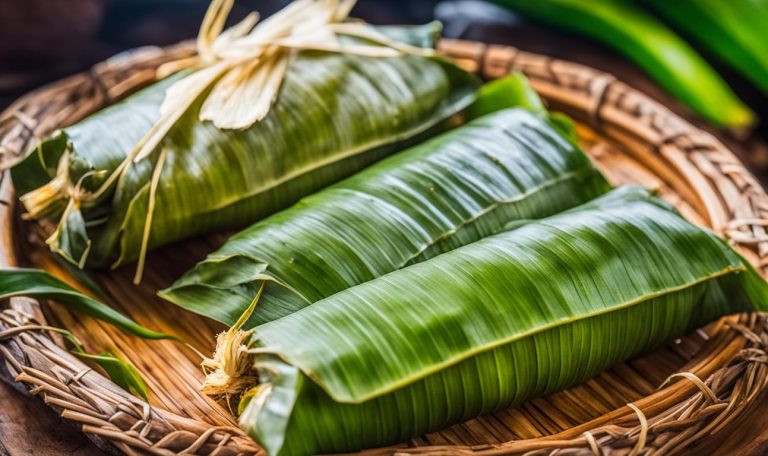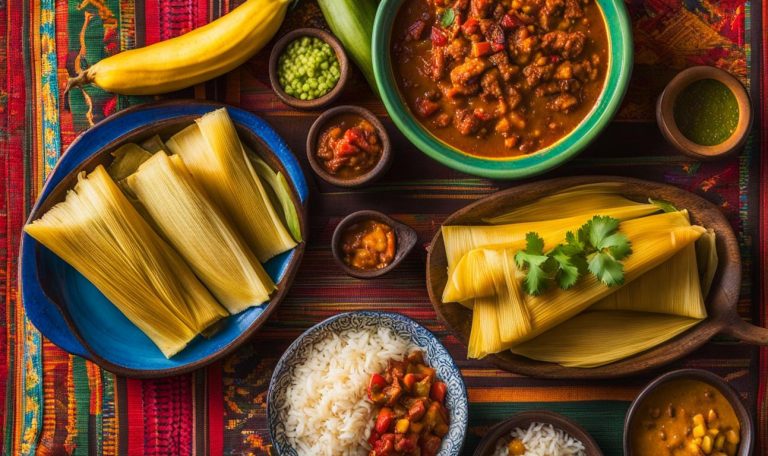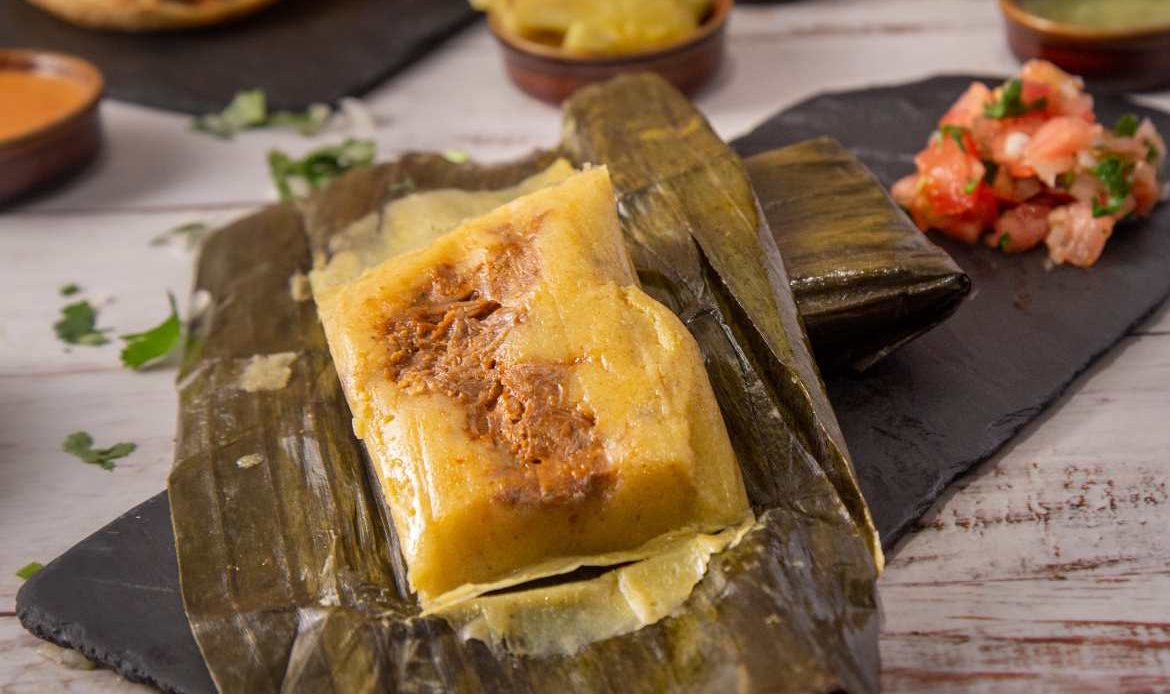Tamales hold a significant place in the Christmas celebrations of Panama and Costa Rica. They are considered a traditional holiday food and are enjoyed by people of all backgrounds. Tamales in these countries are typically made with a variety of ingredients, including corn dough, vegetables, and meat. The preparation process involves wrapping the tamale mixture in banana or plantain leaves and steaming them until cooked. This centuries-old tradition has deep cultural roots and is cherished by locals and visitors alike.
Key Takeaways:
- Tamales are a beloved Christmas tradition in Panama and Costa Rica.
- The ingredients for tamales include corn dough, vegetables, and meat.
- The tamales are wrapped in banana or plantain leaves and steamed.
- This tradition has deep cultural roots and is enjoyed by people of all backgrounds.
- Tamales bring joy and warmth to the holiday season in Panama and Costa Rica.
Origins of Tamales in Panama and Costa Rica
Tamales have a long history in Panama and Costa Rica, dating back to pre-Columbian times. The indigenous people of these regions used corn as a staple ingredient and incorporated it into their everyday meals. The practice of making tamales evolved over time, as Spanish conquistadors arrived and introduced new flavors and traditions. Today, Panamanian and Costa Rican tamales are a blend of native and European influences, representing the rich cultural heritage of these countries.
The corn filling of tamales holds special significance in the history of Panama and Costa Rica. In pre-Columbian times, corn was considered a sacred crop, symbolizing the sun god. The corn dough used in tamales was believed to carry the essence of the sun god, making it a revered food during important celebrations. With the arrival of the Spanish, tamales became associated with Christmas and the immaculate conception. This fusion of indigenous beliefs and Spanish traditions has shaped the tamale tradition that is cherished today.
Over the years, the traditional tamale recipe has been passed down through generations, with each family adding their own unique twist to the dish. The ingredients used in Panamanian and Costa Rican tamales vary, but common elements include corn dough, vegetables, meat such as chicken or pork, and flavorful seasonings. The tamale mixture is carefully wrapped in banana or plantain leaves and steamed until cooked to perfection. The result is a delicious and festive dish that embodies the culinary traditions and cultural heritage of Panama and Costa Rica.
Table: Ingredients Used in Panamanian and Costa Rican Tamales
| Ingredient | Panamanian Tamales | Costa Rican Tamales |
|---|---|---|
| Corn Dough | ✓ | ✓ |
| Vegetables | ✓ | ✓ |
| Chicken or Pork | ✓ | ✓ |
| Seasonings | ✓ | ✓ |
| Banana or Plantain Leaves | ✓ | ✓ |
Through the centuries, tamales have remained a beloved Christmas tradition in Panama and Costa Rica. The origins of tamales in these countries reflect the cultural diversity and the blending of ancient indigenous practices with colonial influences. Today, tamales continue to bring joy and flavor to holiday celebrations, keeping the traditions alive and connecting generations.
The Significance of Tamales in Costa Rican Culture
In Costa Rican culture, tamales hold a special place during the Christmas and New Year holidays. The tamale tradition is deeply ingrained in the fabric of Costa Rican society and is celebrated with great fervor. It is estimated that Costa Ricans consume approximately 196 million tamales during the month of December, with an average of three tamales per person per day.
Tamales are not only a beloved holiday food but also a symbol of togetherness and community. Families and friends gather to prepare tamales in a ritual known as a “tamaleada,” where they engage in conversation, share stories, and bond over the joy of making these delicious treats. The tamaleada tradition is a cherished part of the holiday season, fostering connections and creating lasting memories.
During the Christmas festivities, tamales are sold in markets, restaurants, and grocery stores. They are typically bundled in sets of two, tied with twine, and packaged in a traditional wrapping called a “piña de tamales.” This packaging not only preserves the freshness of the tamales but also makes them convenient for quick and comforting meals throughout the holiday season.
Table: Costa Rican Tamale Consumption during December
| Year | Number of Tamales Consumed |
|---|---|
| 2017 | 180 million |
| 2018 | 195 million |
| 2019 | 196 million |
| 2020 | 200 million |
The tamale tradition in Costa Rican culture is a testament to the importance of food in bringing people together, nurturing traditions, and celebrating the holiday season. The flavors, aromas, and communal spirit of tamales evoke a sense of joy and warmth that is characteristic of the Christmas and New Year holidays in Costa Rica.
Panamanian Christmas Traditions and the Festive Delight of Tamales
Christmas Eve in Panama is a time of joy, celebration, and delicious food. One of the most beloved traditions is the preparation and enjoyment of Panamanian tamales. These savory delights are a staple on the Christmas table and are eagerly anticipated by families across the country.
Marking the occasion with a blend of indigenous and European influences, Panamanian tamales are made with a flavorful mixture of corn dough, raisins, peppers, coriander, olives, and chicken or pork. This tantalizing combination is then carefully wrapped in banana leaves and steamed to perfection. The result is a delightful culinary creation that captures the essence of Panamanian Christmas traditions.
Alongside tamales, another customary treat that graces the Christmas table in Panama is the roscade pan, a beautiful braided bread adorned with almonds. These two dishes often go hand in hand, symbolizing the unity and abundance of the holiday season.
The Joy of Panamanian Tamales and Roscade Pan
The joy of Panamanian tamales and roscade pan lies not only in their delicious flavors but also in the shared experience of enjoying them with loved ones. Families gather around the table, savoring the rich aromas and indulging in the tradition that has been passed down through generations.
“Panamanian tamales and roscade pan are more than just food; they are a representation of our cultural heritage and the spirit of togetherness during the holiday season,” says Maria Diaz, a Panamanian native. “It’s a time to come together, share stories, and create lasting memories.”
As the Christmas season approaches, Panamanians eagerly anticipate the preparation and enjoyment of these traditional dishes. Panamanian tamales and roscade pan embody the festive spirit of Christmas, bringing warmth, joy, and a taste of tradition to every home.
The Tamale-Making Process
Making tamales is a labor of love that involves several steps. To create these delicious holiday treats, you’ll need a variety of ingredients and a bit of patience. Here’s a breakdown of the tamale-making process:
Gathering the Ingredients
Before you begin making tamales, gather all the necessary ingredients. These typically include corn flour, chicken or pork, onion, achiote, raisins, chili peppers, tomato puree, coriander, oregano, salt, pepper, olives, capers, tomatoes, garlic cloves, bell pepper, banana leaves, and thread. Each ingredient plays a crucial role in creating the unique flavors of the tamale filling.
Preparing the Filling
Once you have all the ingredients ready, it’s time to prepare the tamale filling. Start by cooking the meat with the seasonings until tender. Then, mix the stewed meat with the corn flour to create a thick, flavorful masa. Add in the various vegetables, spices, and seasonings to enhance the taste of the filling. The combination of ingredients creates a harmonious blend of flavors that make tamales so delicious.
Wrapping and Cooking
After the filling is prepared, it’s time to wrap the tamales. Lay out a piece of banana leaf and spoon a generous amount of the masa onto it. Fold the leaf around the masa, creating a neat package, and tie it with thread to secure it. Repeat this process until all the masa and filling are used. Once the tamales are wrapped, they are ready to be cooked. Steaming is the traditional cooking method for tamales and ensures that they are cooked thoroughly and evenly. After around 20 minutes of steaming, the tamales will be ready to be enjoyed.
Now that you know the basics of the tamale-making process, you can try your hand at creating these delightful holiday treats. Whether you’re following a traditional recipe or adding your own unique twist, making tamales is a fun and rewarding culinary experience.
The Popularity of Tamales in Costa Rica
Tamales are immensely popular in Costa Rica, with a large majority of Ticos (Costa Ricans) participating in the tamal tradition. According to a survey by the University of Costa Rica, 91.3% of Costa Ricans enjoy tamales during the Christmas season, and 62% of them make their own tamales at home. For those who do not make tamales themselves, an estimated 19 million “piñas de tamales” (bundles of tamales) are purchased. The cost of making tamales can be significant, with the average family spending over $50 for the ingredients to make 50 tamales.
Costa Ricans take great pride in their homemade tamales, with each family having their own unique recipe passed down through generations. Making tamales is often a family affair, with everyone pitching in to prepare the ingredients, mix the masa (corn dough), and assemble the tamales. This tradition not only ensures the authenticity and quality of the tamales but also strengthens family bonds and creates lasting memories.
The popularity of tamales in Costa Rica is not limited to the Christmas season. Tamales are also enjoyed during other special occasions and celebrations throughout the year, such as birthdays, anniversaries, and religious festivals. The delicious flavors, rich history, and cultural significance of tamales continue to make them a beloved and essential part of Costa Rican cuisine.

The Tradition of Tamales Piñas
One unique aspect of the tamale tradition in Costa Rica is the concept of “tamales piñas.” These are bundles of tamales tied together with twine and sold in local markets and grocery stores. Tamales piñas are an easy and convenient way for individuals and families to enjoy tamales without the need to prepare them from scratch. They are often sold in different sizes, catering to various household needs.
| Tamales Piñas Sizes | Number of Tamales | Price |
|---|---|---|
| Small | 6-8 | $5-$8 |
| Medium | 12-14 | $10-$15 |
| Large | 18-20 | $15-$20 |
Tamales piñas are a popular choice for individuals who do not have the time or resources to make tamales themselves. They are also commonly given as gifts during the holiday season, symbolizing the spirit of generosity and sharing among friends and loved ones.
The Tradition of Buying Pre-Made Tamales at Riba Smith Supermarket
In Panama, many families have a beloved tradition of buying pre-made tamales for their Christmas Eve celebrations. One popular spot for purchasing tamales is the Riba Smith supermarket, which has been serving customers since 1956. The demand for tamales during the Christmas season is incredibly high, and people are willing to go to great lengths to secure the last bags of these delectable treats.
While some families still make tamales at home, the convenience of buying pre-made tamales has become a cherished Christmas tradition for many Panamanians. Riba Smith supermarket is renowned for its high-quality ingredients and delicious tamales, making it a go-to destination for those seeking a taste of authentic Panamanian cuisine during the holiday season.
Table: Pros and Cons of Buying Pre-Made Tamales
| Pros | Cons |
|---|---|
| Convenient and time-saving | Limited customization options |
| Consistent quality and taste | Potential for higher cost |
| Supports local businesses | May sell out quickly |
Buying pre-made tamales allows families to spend more time enjoying the holiday festivities and less time in the kitchen. It also supports local businesses like Riba Smith supermarket, which make it their mission to provide customers with delicious, ready-to-eat tamales. While there may be limited customization options compared to homemade tamales, the consistent quality and taste offered by pre-made tamales are sure to satisfy even the most discerning palates.
Whether you choose to make your own tamales or opt for the convenience of pre-made tamales, the tradition of enjoying these savory delights during the Christmas season is a cherished part of Panama’s culinary heritage.
The Joy of Tamales During Christmas
During the Christmas season, tamales bring joy and warmth to the hearts and homes of people in Panama and Costa Rica. These delicious treats not only delight the taste buds but also hold a special significance in the holiday traditions of both countries. In Costa Rica, the “tamaleada” tradition is a time for friends to come together, sharing tamales, coffee, and good conversation. It’s a festive occasion that celebrates the joy of the season and the joy of community.
For many, tamales are more than just a food; they are a gift. Wrapped in banana leaves, they are perfectly packaged and ready to be enjoyed. In both Panama and Costa Rica, tamales are often given to friends, neighbors, and loved ones as a gesture of love and goodwill. The gift of tamales not only brings a smile to the recipient’s face but also represents the spirit of generosity and sharing that embodies the holiday season.
Whether enjoyed at a tamaleada or exchanged as a gift, tamales hold a special place in the hearts and traditions of Panama and Costa Rica. The joy they bring during the Christmas season is a testament to the rich cultural heritage and culinary pride of these countries. So, as the holiday season approaches, let us savor the delight of tamales and embrace the traditions that make this holiday staple so special.
| Benefits of Tamales During Christmas |
|---|
| Brings joy and warmth to the holiday season |
| Represents the spirit of generosity and sharing |
| Connects friends and family during the tamaleada tradition |
| Symbolizes the cultural heritage and culinary pride of Panama and Costa Rica |
The Tamaleada Tradition
The tamaleada tradition is a cherished part of the tamales’ tradition in Costa Rica. It involves inviting friends and loved ones over for an afternoon gathering to share tamales, coffee, and good conversation. The tamaleada is not only a time to enjoy delicious food but also an opportunity to connect with loved ones and create lasting memories. It is a tradition that embodies the joy and togetherness of the holiday season.
The Practicality and Flavor of Tamales
Tamales are not only a delicious Christmas tradition but also a fast comfort food that brings joy to the holiday season in Panama and Costa Rica. The combination of flavorful ingredients makes them a favorite among locals and visitors alike. The traditional recipes passed down through generations add a unique twist to these beloved treats.
With their easy reheating process, tamales are not only a tasty meal but also a convenient option for busy holiday gatherings. The compact size and the use of banana leaves as wrappers allow for quick and mess-free serving. Whether shared at a tamalada or enjoyed at home, tamales provide a comforting and satisfying experience.
Each family has its own variations of the traditional tamale recipe, using a variety of ingredients such as seasoned masa, sweet pepper, carrot, rice, onion, potato, green beans, and pork. The flavorsome combination of these ingredients creates a delightful burst of taste in every bite. Tamales truly capture the essence of Panamanian and Costa Rican culinary traditions, making them a must-have during the holiday season.
Traditional Tamale Recipe
| Ingredients | Instructions |
|---|---|
| Masa dough | Mix the masa dough with water or broth until smooth. |
| Seasoned meat | Cook the meat with onion, garlic, and various spices. |
| Vegetables | Add a variety of vegetables like sweet pepper, carrot, onion, and green beans. |
| Assembly | Spread a small amount of masa dough on a banana leaf, add the meat and vegetables, then fold and tie the leaf. |
| Steaming | Steam the tamales until the masa is cooked and firm. |
Whether enjoyed as a quick meal or shared with loved ones during the holiday season, tamales in Panama and Costa Rica are a flavorful and versatile comfort food. The practicality of their preparation and the richness of their flavors make them a beloved tradition that continues to be treasured today.
Keeping Tradition Alive
Preserving culinary heritage is of utmost importance in Panama and Costa Rica, where the significance of tamales goes beyond the delicious flavors they offer. Tamales are deeply rooted in the cultural fabric of these countries, and maintaining the traditions associated with them is a way to honor their rich history and bring communities together.
In both Panama and Costa Rica, generations have passed down recipes, techniques, and stories surrounding the making and enjoying of tamales. Families take pride in preserving these traditions and passing them on to future generations. During the Christmas season, the preparation of tamales becomes a shared activity, strengthening bonds and fostering a sense of unity.
The cultural significance of tamales is evident in the tamaleada tradition in Costa Rica, where friends gather to share tamales and engage in meaningful conversations. This cherished practice not only celebrates the culinary heritage but also serves as a reminder of the importance of connection and community.
By keeping the tradition of tamales alive, Panama and Costa Rica ensure that their cultural heritage remains vibrant and cherished. The flavors, customs, and communal gatherings associated with tamales become lasting memories, celebrating not just the Christmas season but also the unique identity of these countries.
The Delight of Tamales Across Borders
Tamales, with their rich flavors and cultural significance, have gained international appeal beyond their origins in Panama and Costa Rica. Latin American cuisine, including tamales, is celebrated worldwide for its authentic flavors and diverse culinary traditions. The distinct taste of a well-made tamale captures the essence of Latin American culture and showcases the region’s love for delicious food.
The international appeal of tamales can be attributed to their unique blend of ingredients and the skillful techniques used in their preparation. Each country has its own variation, resulting in a wide range of flavors and textures. From the savory and spicy tamales of Mexico to the sweet and spiced tamales of Nicaragua, there is a tamale for every palate.
Food enthusiasts and travelers alike seek out tamales as a way to experience the authentic flavors of Latin America. These traditional delights have become a popular addition to festive meals, not only during the Christmas season but throughout the year. Whether enjoyed at a local restaurant or made from scratch in a home kitchen, tamales offer a taste of Latin American culture that is both comforting and exciting.

Conclusion on Tamales in Panama and Costa Rica
Tamales hold a special place in the Christmas traditions of Panama and Costa Rica, symbolizing the cultural heritage and culinary pride of these countries. These delicious treats are not only a holiday staple but also a way for families and communities to come together in celebration. Whether enjoyed at a tamaleada or bought from a local market, tamales bring joy and warmth to the holiday season.
As the Christmas festivities approach, let us embrace the traditions that make tamales so special. From the origins of tamales in pre-Columbian times to their evolution into beloved Christmas dishes, the significance of tamales in Panama and Costa Rica runs deep. These culinary delights are not only a testament to the rich history of these countries but also an invitation to savor the flavors and customs that have been passed down through generations.
So, as you gather with loved ones this Christmas, take a moment to appreciate the cultural heritage that tamales represent. Whether you indulge in a tamaleada or enjoy a homemade tamale, let the flavors and traditions of Panama and Costa Rica fill your heart with warmth and joy. Tamales truly embody the spirit of Christmas, bringing people together and creating lasting memories for years to come.
FAQ
How long have tamales been a part of Christmas celebrations in Panama and Costa Rica?
Tamales have been a part of the Christmas celebrations in Panama and Costa Rica since pre-Columbian times.
What are the traditional ingredients used in Panamanian tamales?
Traditional Panamanian tamales are made with corn dough, raisins, peppers, coriander, olives, and chicken or pork.
How are tamales cooked in Costa Rica?
Tamales in Costa Rica are typically cooked by steaming them until they are fully cooked.
How many tamales do Costa Ricans consume during December?
Costa Ricans consume an estimated 196 million tamales during December, averaging around three tamales per person per day.
Where can you buy tamales in Panama?
Tamales can be purchased at various places in Panama, including the Riba Smith supermarket.
What is a tamaleada?
A tamaleada is a tradition in Costa Rica where friends gather to share tamales and good conversation.
What ingredients are used in the tamale-making process?
The main ingredients used in making tamales include corn flour, chicken or pork, onion, achiote, raisins, chili peppers, tomato puree, coriander, oregano, salt, pepper, olives, capers, tomatoes, garlic cloves, bell pepper, banana leaves, and thread.
How much do Costa Rican families spend on ingredients to make tamales?
The average Costa Rican family spends over $50 for the ingredients to make 50 tamales.
How do tamales bring joy and warmth to the Christmas season?
Tamales bring joy and warmth to the Christmas season by being a delicious and comforting food that is often shared with loved ones during festive gatherings.
Are tamales popular outside of Panama and Costa Rica?
Yes, Latin American cuisine, including tamales, has gained international recognition and is appreciated by food enthusiasts worldwide.



